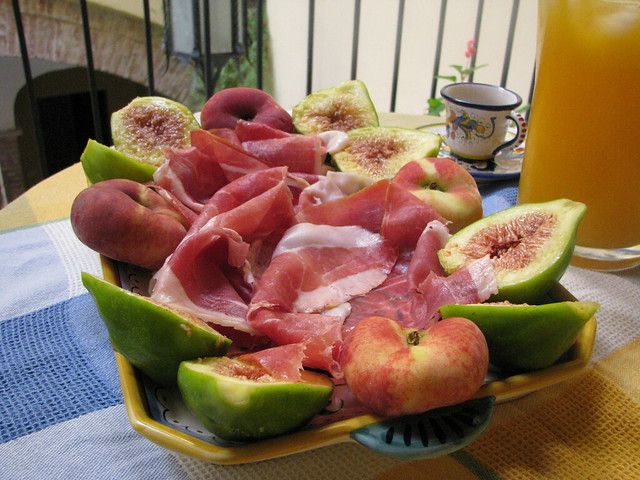Though you are likely to have some of the most memorable meals in your life while traveling in Italy, breakfast will probably not be one of them. In a country where the cuisine is based on local traditions, fresh ingredients, and nutritiously sound principles, the average breakfast in most of the country is a perplexing aberration.
Alongside their cappuccino or tea, an Italian will gulp down a “cornetto” if having breakfast at the corner bar – what cafés are called in Italy – or a handful of breakfast cookies (yes, cookies) and a fruit juice or yogurt if eating at home. There is very little variety at the breakfast table, though Kellogg cereals have started to become popular over the past decade, and what little variety there is remains within the category of highly sweetened and refined processed foods.

(Photo by Concierge in Umbria via Flickr)
Of course, breakfast wasn’t always like this. Most older Italians, especially those from the small towns and rural areas, remember growing up with a savory breakfast of legumes, bread and olive oil, or homemade charcuterie and cheeses. As excellently explained in this Eater article, the post-war economic prosperity and the shift away from an agricultural economy spawned both the trend of eating breakfast at the bar and the rise in commercial breakfast foods, primarily mass-produced frozen or packaged cornetti and breakfast cookies. What is considered the “traditional” morning repast in Italy now isn’t traditional at all, but a cultural phenomenon that began in the 1970’s.
So, what are your breakfast options in Italy? Here is an overview:
Breakfast Like an Italian
Though not the healthiest of choices, a week of eating breakfast like an Italian won’t do you lasting harm. Head to the corner bar-pasticceria (a simple bar will probably only serve commercially made cornetti, and a simple pasticceria may not have cafè service) and order a “cappuccino e cornetto, per favore”. If you want the truly authentic experience, you can consume your breakfast standing at the bar elbow to elbow with neighborhood Italians in two minutes flat, otherwise carry your order to a table and eat sitting down.

(Photo by Concierge in Umbria via Flickr)
Cornetti come in a variety of flavors, including “semplice” with nothing inside; with “marmellata”, or jam; “crema”, or custard; “cioccolato”, which can be chocolate custard, melted chocolate, or Nutella; and “miele”, or honey. A good pasticceria will make their own cornetti, or you can splurge on a more elaborate pastry from the selection: in Rome, try a “maritozzo”, a sweet bun filled with whipped cream; in southern Italy, opt for a “sfogliatella”, a flaky pastry cone filled with sweet ricotta and orange peel; in Florence, order a “sfogliatina”, a flaky pastry square or pocket with apples, pastry custard, or sweet rice custard; and in Venice, of course, sample a “veneziana”, a sweet brioche topped with pastry custard.
Breakfast like a Continental
If you are staying at a hotel, you will almost certainly have some form of a continental breakfast available each morning. These breakfast buffets range from Italian continental – offering a variety of sweet cakes and pastries, bread with butter and jam, yogurt, cereals and milk, juice, and fresh fruit – to full continental – with the addition of a selection of charcuterie, cheeses, and hardboiled eggs. Your drink order will almost always be taken by the breakfast staff when you are seated, so your cappuccino, espresso, or tea will be made fresh.

(Photo by Concierge in Umbria via Flickr)
Larger, luxury hotels which cater to an American and English clientele are beginning to offer more hearty and varied breakfast options, so you may find an egg station where you can request a freshly-made omelette with vegetables or ham, or an entire section of the buffet dedicated to organic and healthy breakfast options, including organic fruit and juices, organic yogurt, whole grain breads, and muesli or granola cereals. The buffet may include chafing dishes of bacon or sausages, scrambled eggs, baked ham, or potatoes, and in very rare cases, there is a breakfast menu with American classics like pancakes or waffles which can be ordered a la carte and are not included in the price of the buffet breakfast.

(Photo by Concierge in Umbria via Flickr)
Breakfast like home
If you are booked in a villa with a kitchen, you can stock up on your favorite breakfast dishes and stick to your morning routine from home. Almost all the basic ingredients of an American breakfast can be found in Italy, including staples for making pancakes (there is even shockingly expensive but authentic maple syrup to be had), bread and jam for toast, eggs, basic cereals like corn flakes and granola, oatmeal, milk, and juice. You can improvise bacon with “pancetta affumicata”, though you will not find breakfast sausage or frozen waffles. Though there are drip coffee machines for making American-style coffee, which well-stocked villa kitchens often supply, coffee ground specifically for drip machines is often hard to find so you may have to use espresso grounds.

(Photo by Concierge in Umbria via Flickr)
However you decide to begin the day, remember that Italians break up the morning with “merenda”, an elevenses-style mid-morning snack that can be a savory sandwich or slice of pizza or a sweet pastry or cake.


